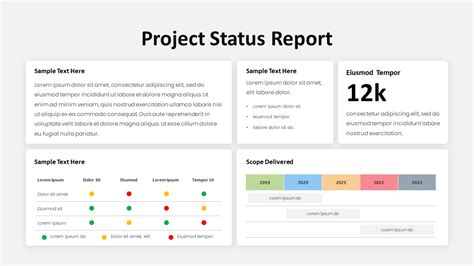Project status report templates are essential tools for project managers to effectively communicate the progress, health, and outlook of their projects to stakeholders, team members, and sponsors. These templates, particularly when designed as PowerPoint (PPT) slides, offer a structured and visually engaging way to present complex project information. Below, we'll outline the key elements that make up a comprehensive project status report template in PPT format, ensuring that your reports are clear, concise, and engaging.
1. Introduction/Executive Summary
Introduction/Executive Summary
This section provides a brief overview of the project, including its objectives, timelines, and the purpose of the status report. It's crucial for setting the context for the rest of the report.

Key Points:
- Brief project overview
- Objectives and key performance indicators (KPIs)
- Purpose of the status report
2. Current Project Status
Current Project Status
This section is the heart of the status report, detailing the current state of the project in terms of progress, milestones achieved, and any deviations from the plan.

Key Points:
- Progress against the project timeline
- Milestones completed and upcoming
- Current project performance metrics (e.g., burn-down charts, velocity)
3. Issues, Risks, and Dependencies
Issues, Risks, and Dependencies
This part of the report highlights any issues that are currently impacting the project, potential risks that could affect it, and dependencies that are critical to its success.

Key Points:
- Current issues and their status
- Identified risks and mitigation strategies
- Critical dependencies and their status
4. Action Items and Next Steps
Action Items and Next Steps
Outline the tasks that need to be accomplished by the project team and stakeholders, along with timelines for completion. This ensures everyone is aware of their responsibilities and deadlines.

Key Points:
- Task assignments and deadlines
- Any decisions or approvals needed from stakeholders
- Overview of the next reporting period
5. Conclusion and Appendices
Conclusion and Appendices
This final section summarizes the key points from the report, reiterates the project's status, and provides any supporting documents or detailed information that stakeholders might find useful.

Key Points:
- Recap of the project status
- Call to action for stakeholders
- Appendices with detailed data or supporting information






FAQ Section:
What is a project status report?
+A project status report is a document that updates stakeholders on the current status of a project, highlighting progress, issues, and future steps.
Why is a project status report important?
+It's essential for keeping stakeholders informed, managing expectations, and ensuring the project stays on track to meet its objectives.
How often should project status reports be delivered?
+The frequency depends on the project's complexity, duration, and stakeholders' needs, but it's common to deliver these reports weekly or bi-weekly.
Conclusion: Effective project status reports are critical for the success of any project. By using a structured PPT template and focusing on key elements such as the executive summary, current project status, issues and risks, action items, and appendices, project managers can ensure that stakeholders are well-informed and that the project remains on track to meet its objectives.
